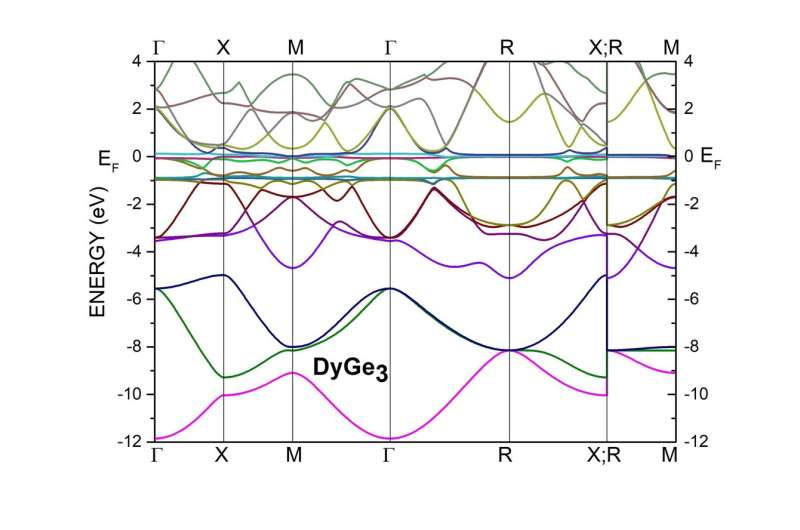Physicists study complex magnetism in a rare earth compound

Dysprosium germanide (DyGe3) is a silver-white compound that forms refractory oxides that are almost insoluble in water. In a recent study, scientists applied the pressure of eight GPa to obtain polycrystal samples of dysprosium germanide in a metastable state state of local thermodynamic equilibrium capable of changing to a more stable state under certain conditions.
The physicists found a charge-density wave (CDW) in this compound—a phenomenon that occurs in some crystals at low temperatures due to the peculiarities of their electron structure. A CDW describes space-periodic modulations of ions and electron density, i.e., the oscillating space probability of finding electrons and ions along the CDW propagation.
Recent studies have focused on the physics of CDW in rare earth compounds and how this wave influences crystal lattice distortions and magnetic ordering. Magnetic ordering implies a spontaneous alignment of vectors of atomic magnetic moments in a substance. These vectors located at atom positions can point either parallel (ferromagnetic order) or anti-parallel (anti-ferromagnetic order) to each other. A few years ago, scientists discovered that a CDW can precede and co-exist with the anti-ferromagnetic order.
When the temperature is lowered, CDW appears in the dysprosium germanide, followed by a transition to an anti-ferromagnetic order at still lower temperature.
"We've discovered that when the crystal lattice structure is slightly distorted, the local crystal site symmetry around certain atoms changes, and the substance experiences a transition to CDW. The wave influences magnetic properties of the material, causing the appearance of a spiral magnetic structure," said co-author Alexander Nikolaev, doctor of physical and mathematical sciences, and lead researcher at the laboratory of electron-nuclear and molecular processes of SINP.
According to the team, the results illustrate the mechanisms of correlation between charge and spin characteristics in an electron system. Charge is associated with CDW, and spin with anti-ferromagnetic order.
"Our work focuses mostly on fundamental issues of condensed-matter physics, which include magnetism and structural phase transition. In the future, this work can lead to a better understanding of complex magnetism in rare earth compounds and the appearance of new prospective materials," concluded the scientist.
More information: D.A. Salamatin et al, Coexistence of charge density wave and incommensurate antiferromagnetism in the cubic phase of DyGe 2.85 synthesised under high pressure, Journal of Alloys and Compounds (2018). DOI: 10.1016/j.jallcom.2018.04.319
Provided by Lomonosov Moscow State University



















